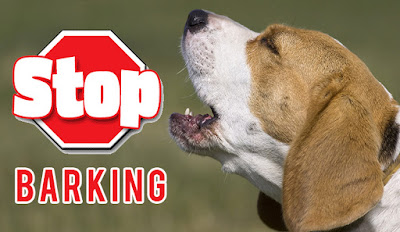Non-BRAKING
Ways to Stop Your Pooch from BARKING
Isn’t
it frustrating and irritating when you furry pal goes on barking in the
backyard or just barks when you are out with him.
This
seems to be most common problem in many of the dogs, where some pet owners are
helpless; the others really don’t know how to tackle with this issue. There is
no quicker and easier solution for this complicated and tricky issue. But,
surely working on some of the things, indulging in proper cohesive parameters,
you can divulge out an effective way to stop your dog from barking.

Working
on some concrete steps, you can try to stop your dog’s barking in the yard. Do
realize it is the matter of patience and time, so don’t overrun on conclusions
when you face failure during the starting phase. Let us begin now.
Find out the provocative
entities
What
is causing the dog's barking? This is an essential question that you need to ask
yourself when you find your dog barking in the yard. There are always dog
triggers that initiate barking in your dog. Some of these provocative entities
may be little animals such as rodents, squirrels, rabbits, etc. There can be
non-visual triggers also such as distant traffic, machinery voice on the other
side of the yard, ice breaking on the lakes, snowmobilers, and many other such
noises.
Different
dogs have different triggers. Sometimes, for dogs it is just a fun game to go
on barking. They just keep on doing this as they like the fun and want to carry
it on.
Find a strategy to block these
provocative entities
The
best way you can do is to redirect your pooch’s attention when he is on this
barking mission. After finding out the triggers, try to remove them which may
be likely to take away from that place. You can even leash your dog to make him
remove from triggers. This is the best way of teaching your dog a positive
response.
Enroll in dog training or start
on your own
In
order to control dog barking, you can enroll your pet in dog training, where he
can learn to stop barking unnecessarily. In case, you are not so found of these
training sessions, then you can start on your own.
·
With
the help of leash and good treats, you can inculcate a standard norm of
behavior in your pooch. A long lead with little freedom, while still you have
the hold to control will get his attention as needed.
·
Treats
also act as good bark controlling tools. Giving treats to distract their
attention from triggers is a simple and easy solution.
Train your dog to act on your
“quiet” command
This
may look bizarre and out of the way, but the first step of this strategy is to
teach your dog to bark on your command. Give your dog command to speak and wait
for him to bark three to four times. Then bring treat near him and when he
indulge in sniffing and stops barking, praise him and give the treat.
First
carry out in calm surroundings without distractions to tell him to speak and
them command him to be quiet and give him a treat and appreciate him to be
quiet, when he follows you.
Repeat
this program many times and eventually your dog will act on your “quiet”
command.
Keep your dog tired
Along
with reasoning out provocative entities, ensure that your dog involves in
physical and mental activities daily. A tired dog is less likely to bark
ignoring the triggers and barking from boredom or frustration. Depending on the
breed, age and size, you can plan out games and exercises keeping him engaged.
Interactive toys can also be very much useful in such cases where you would
like to control the barking of your dog.

